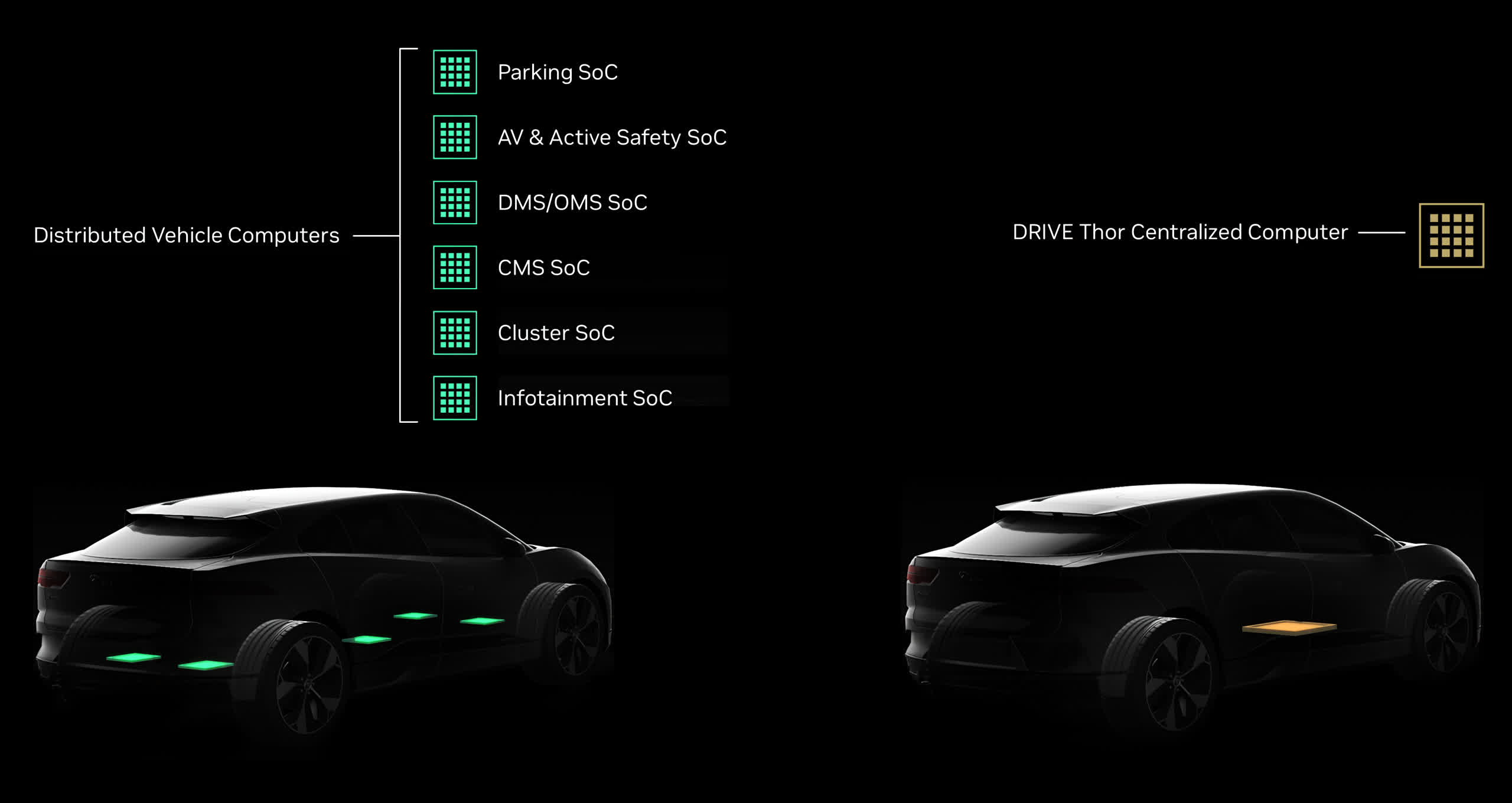From PCs to vehicles: Nvidia, Qualcomm and Intel race to automotive semis
 [ad_1]
[ad_1]
Ahead-looking: 1 of the biggest problems for big semiconductor companies is that they ought to make huge bets on crucial technologies and marketplaces many a long time before they come to be commonplace. In our significantly electronic world, chips are the main base-degree component vital to permit new varieties of improvements that, in flip, direct to the creation of new product or service types or the reinvention of more mature ones. These types of is the circumstance of present day automobile market place, which is observing a transformation of capabilities, architecture, and design and style all remaining pushed by chip-powered digital technologies.
Quite a few years back, a lot of of the world's major semiconductor businesses, such as Nvidia, Qualcomm, Intel and some others started producing plans for what they saw as the upcoming major electronic system class: the clever linked car or truck.
Now, as we start to see the debut of design calendar year 2023 cars with increasingly complex tech-enabled functions, it is really becoming apparent that those people early bets are starting up to payoff. Each and every of these significant tech sellers -- all of whom have commonly targeted on close user computing equipment like PCs and smartphones -- are producing vital inroads into the automotive market. In reality, each are now starting up to emphasize indicators of the increasing importance that getting a motor vehicle component supplier is obtaining on their respective base lines.
At its modern GTC convention, for illustration, Nvidia highlighted how it is leveraging its following generation GPU technologies for a wide range of distinct automotive purposes, like assisted and autonomous driving, as very well as infotainment capabilities. Likewise, Qualcomm held an trader working day final thirty day period that discussed the company's rapidly escalating pipeline of automotive-centered business enterprise. At last, Intel just introduced that it will be spinning out its Mobileye division in what it hopes will prove to be a big economic windfall following getting the ADAS (Superior Driver-Support Systems) technology-concentrated, Israel-dependent organization in 2017.
In Nvidia's case, the enterprise has now unveiled a lot of earlier iterations of its GPU-driven technologies for the motor vehicle marketplace, but with each and every successive era, the firm is enabling extra impressive abilities and achieving into new purposes. Soon after a long time of accomplishment driving automobile infotainment methods, the company took on the a lot more hard undertaking of assisted driving functions and now proceeds to get the job done toward greater stages of autonomous driving.
The company's new Travel Thor platform is powered by the most recent Ada Lovelace era of GPU engineering, the newest Arm-based Grace CPU know-how that the company announced earlier this calendar year, and the AI capabilities from the firm's Hopper multi-occasion GPU tech for AI acceleration.

With Drive Thor, automakers can consolidate intelligent vehicle functions on a solitary SoC.
Collectively, these enable a whopping 2 teraflops of functionality. In real world phrases, that signifies that Push Thor can be utilised to permit most of the important technological know-how-driven functions found in a present day car or truck -- including ADAS and some autonomous driving capabilities, automated parking, infotainment regulate, driver and passenger monitoring, and instrument cluster regulate -- from a single system.
This is an important progress mainly because formerly a lot of of these functions have been operate by different chips. In point, quite a few car or truck makers or Tier 1 automotive suppliers would frequently select chips from various sellers to run these diverse capabilities. That is why it grew to become comparatively common to hear several chip sellers chat about how they gained business enterprise from the same vendor and from time to time even the exact models. They have been getting made use of for distinctive capabilities.
With Generate Thor, Nvidia is supplying motor vehicle suppliers, starting off with their 2025 types, the skill to commence integrating much more of these features into a solitary system. Given the monumental complexity of today's vehicles, which is a probably huge get for absolutely everyone associated. For Nvidia, of study course, it gains additional of the company and establishes by itself as an even much more critical supplier. For carmakers, the integration of several features into a single electronic system can help simplify the all round architecture of the car, which need to guide to more dependable procedure, and reduce the charges and complexity related with combining many platforms into a single car or truck.
Push Thor allows this multi-purpose assist by jogging a number of different apps at the same time via a virtualized software package ecosystem (conceptually identical to what servers do in info facilities and in the cloud) that Nvidia refers to as multi-domain computing.
In essence, this will allow Push Thor to replicate in computer software the several bodily domain controllers that have driven several automotive functions inside of autos for decades. Also, distinctive to Drive Thor versus preceding technology Nvidia automotive components is an inference transformer motor, which the enterprise promises can provide a 9x improvement working the forms of neural networks that are at the heart of assisted and autonomous driving capabilities. Rounding out the news, Nvidia also announced that China car or truck enterprise Zeeker (element of the Geely Automotive Team, which also owns Volvo) will be the first to use Generate Thor as its computing platform starting up with automobiles built in 2025.
At its Automotive Investor Working day, Qualcomm also introduced (nevertheless did not element) a new automotive technologies offering called the Snapdragon Experience Flex SoC. Like Nvidia's Drive Thor, Qualcomm's Trip Flex is supposed to be potent more than enough to assistance all the important compute-run driving functions in a good, related auto, but comprehensive details on the chip aren't envisioned right until CES 2023 on January.
Qualcomm has also been releasing merchandise for the automotive sector for a lot of several years now and, back again in early 2022, released a renewed automotive method with the Snapdragon Digital Chassis plan. Electronic Chassis integrates various unique functions, this sort of as Snapdragon Electronic Cockpit for in-automobile infotainment and Snapdragon Journey for assisted and autonomous driving, into a one system that carmakers can possibly choose and pick out from, or consider as one -- a path that could become more common with the debut of the Experience Flex SoC.
Qualcomm's history with the car or truck market goes substantially even more back again, as it really is been providing communications peripherals these as mobile modems, Wi-Fi, and Bluetooth chips for cars and trucks for various many years. Most telematics devices like GM's OnStar and its equal, are normally driven by Qualcomm's connectivity chips. Moreover, presented the progressively program-described nature of modern vehicles, as perfectly as the crucial need to have and probable new enterprise option for more than-the-air upgrades, the "connected" section of the wise, linked automobile is starting to be substantially much more critical.
As a result of those extended-phrase connections, the corporation introduced at its trader occasion that its pipeline for automotive earnings experienced grown from $19 billion to $30 billion more than the class of just a handful of months, highlighting the momentum it is looking at with associates like Acura, Audi, BMW, Cadillac, Jaguar, and Stellantis. In addition, Qualcomm unveiled a partnership with Mercedes Benz to carry the Digital Cockpit features and the Snapdragon Automotive Connectivity Platform into foreseeable future Mercedes cars.
For its part, Intel declared designs to spin out its Mobileye division in a commonly expected IPO. Mobileye has been the early chief in assisted driving functions through digicam-pushed and sensible map-based know-how and has proven partnerships with almost all the large vehicle companies all-around the world. Not too long ago, the firm added assistance for lidar and other sensors with its True Redundancy platform and is increasingly relocating toward additional autonomous driving features.
When Intel procured Mobileye just in excess of 5 years back, it was one of the 1st signals of the increasing relevance of the automotive sector for significant semiconductor providers. Because then, Intel has ongoing to nurture the enterprise and assisted it to expand. Now it hopes to be in a position to "cash in" on its investment with the newly declared IPO and leverage some of people money for its personal intense plans for new chip production websites.
Sensible, linked automobiles are going to be an extremely vital part of the upcoming development of not only the big chip companies like Nvidia, Qualcomm, Intel, and AMD, but of lesser-acknowledged kinds
As with quite a few very long-time period predictions, not every thing about how the significant semiconductor businesses and the automotive industry would get the job done together has panned out as in the beginning predicted. Following all, we are nevertheless a very very long way from thoroughly autonomous Degree 5 autos for persons -- in spite of the tech industry's sturdy prognostications and substantial initiatives.
Nonetheless, there's no issue that wise, related automobiles are heading to be an incredibly important component of the potential growth of not only the massive chip companies like Nvidia, Qualcomm, Intel, and AMD, but of lesser-known kinds like Marvell, Lattice Semiconductor, and a lot of many others.
In reality, recent studies from significant investment decision banking companies have instructed that 45% of a car's parts could be tech-linked in the up coming 10 years or so. As the high tech connection to the automotive market continues to evolve, we're also commencing to witness big progress in cloud related products and services for cars and trucks. In sum, it truly is a fantastic (and telling) example of the form of impact that semiconductors and tech can have on common industries total. It also could be a foreshadowing of other interesting re-invention possibilities however to appear.
Bob O'Donnell is the founder and main analyst of TECHnalysis Investigation, LLC a know-how consulting company that delivers strategic consulting and market investigation services to the technologies marketplace and professional financial local community. You can abide by him on Twitter @bobodtech.
Image credit score: Riccardo
[ad_2] https://g3box.org/news/tech/from-pcs-to-vehicles-nvidia-qualcomm-and-intel-race-to-automotive-semis/?feed_id=10451&_unique_id=633e48030ec66


0 comments:
Post a Comment